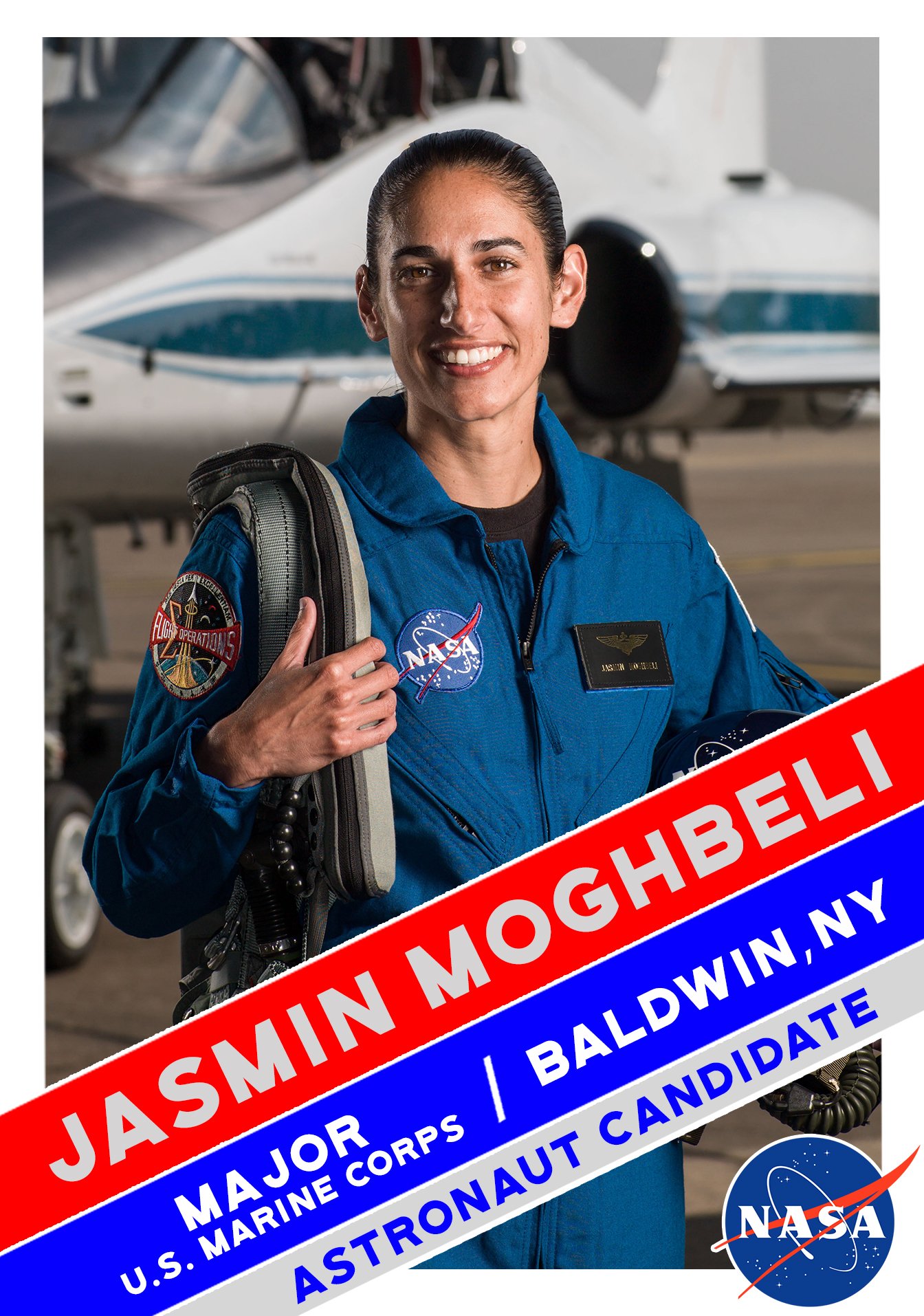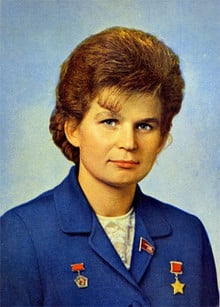
Two decades ago, a young Jasmin Moghbeli decided she wanted to be an astronaut. She researched Valentina Tereshkova, the first woman in space, for a school project, and she knew then that space exploration was her goal.
But by 2010, that dream had slipped a bit further away. Moghbeli was flying AH-1 Cobra missions in Afghanistan and loving her job as a Marine Corps pilot.
When NASA sought applications in 2015 for its next class of astronauts, though, Moghbeli knew it was now or never – and out of more than 18,000 applicants, she was selected to achieve her childhood dream of training to become an astronaut.
Maj. Jasmin “Jaws” Moghbeli, who spoke to USNI News on June 15, said she’s thrilled about her selection and that, wherever her NASA career takes her, “going to space at all still sounds incredible to me.”
As a kid in Baldwin, N.Y., Moghbeli was drawn to math and science.
“In sixth grade we had to do a book report, and I chose to do mine on Valentina Tereshkova, the first woman in space, cosmonaut. So that got me interested in space,” she said.In
“And we dressed up as the person we did the book report on, so my mom helped me make this space suit and everything. So that kind of got me interested and I was like, yeah, I want to be an astronaut. As a kid I think it was just the excitement of exploring space and it just sounded cool. As I got older, junior high, early high school, I started looking into, how would I become an astronaut, and that kind of got me looking into military aviation.”

Moghbeli said she came close to attending the U.S. Naval Academy but was surprised to receive an acceptance letter from the Massachusetts Institute of Technology and selected MIT’s aerospace engineering program. Between her junior and senior year she went through Officer Candidate School and was commissioned a second lieutenant after graduation.
Still with a space career in mind, Moghbeli assumed she’d need to fly fighter jets to be a viable candidate for NASA. She fell in love with rotary wing aviation during basic training, though, which left her unsure how to proceed.

“In the back of my mind I was kind of like, I don’t think you can be an astronaut if you’re flying helicopters. I was a little torn,” she said.
She had an opportunity to watch a night shuttle launch just before starting flight school, though.
“Suni Williams had launched on that – she was one of the crew of seven, and she’s a Navy helicopter pilot – so I was like, oh, you can be a helicopter pilot and still be an astronaut,” she said, and shortly afterwards she was selected to fly Cobras.
Though her dream of becoming an astronaut weighed on her decisions up until that point, Moghbeli said being a naval aviator took on a life of its own.
“When I was flying Cobras in Afghanistan, I never once was thinking about being an astronaut, and I can say genuinely that if you had asked me in that moment if I would leave and become and astronaut right then, I don’t honestly know if I would have said yes, because I was in a moment enjoying what I was doing,” she said.
In 2013 NASA sought applicants for a class of astronauts. Recently back from a float with the 31st Marine Expeditionary Unit out of Japan, Moghbeli didn’t think the time was right and didn’t feel qualified for the job.
“I didn’t think I had a viable application – I was still not a senior pilot, I still hadn’t had test pilot school, I didn’t have my Masters. So I had been staying on top of it and I was expecting, just based on they had been doing them every four to five years, I was expecting them to do one around the same timeline,” she said. Instead, two years later, in December 2015, the call for applicants went out again.
“This time around I decided to apply because I felt like I had what they were looking for, so if I had a shot of getting it it was going to be now,” she said.
 The first step was simple: submit a resume, five references and a summary of aeronautical experience. She did that in February 2016, and began the waiting game. More than 18,000 people applied, and NASA whittled that down to less than 500 applicants to begin calling references. Moghbeli heard from her references that they had been contacted, but it wasn’t until August or September that NASA called to invite her to a first-round interview.
The first step was simple: submit a resume, five references and a summary of aeronautical experience. She did that in February 2016, and began the waiting game. More than 18,000 people applied, and NASA whittled that down to less than 500 applicants to begin calling references. Moghbeli heard from her references that they had been contacted, but it wasn’t until August or September that NASA called to invite her to a first-round interview.
She said she “dropped everything” and said she was free to come to Johnson Space Center any time, even though she was set to begin a class around that time.
The 33-year-old spent three days with nine other candidates, interviewing in front of the Astronaut Selection Board, going through teamwork exercises and more.
“After the first round and second round and meeting the other applicants, I left wanting the job even more but knowing I couldn’t be disappointed if I didn’t get it because all the other applicants were amazing,” Moghbeli said.
“I feel so lucky to have gotten the job because every single one of the people who I met throughout the process I think could have been just as successful. So for whatever reason they chose me as one of the 12 and I’m very thankful for it.”
After a call in December to come in for a second-round interview, where she got to meet current astronauts, as well as the engineers, medical staff and other behind-the-scenes teams, “after that I was just waiting for months for the call.”
“The first people I called after I got the call from the Astronaut Selection Board were my parents, and my mom later told me they were at a pizza place when I called and my dad was crying so hard he couldn’t even drive home because he was so excited,” she said.
“My dad is super excited. My mom is as well, but I think she gets nervous. She’s like, well can you be an astronaut but just not go to space?”

The next steps – two years of training – will be physically and mentally challenging, but Moghbeli said her time in the Marine Corps has prepared her for what lies ahead.
Moghbeli serves as a quality assurance officer and avionics officer with Marine Operational Test & Evaluation Squadron 1 (VMX-1), where she tests out new systems headed to the Cobra fleet. As an operational tester, she and her crew are the final thumbs up or down before sending new systems to the fleet. Just prior to this job, Moghbeli worked on the developmental test side, flying new software and weapons, and serving as project officer for tests on a new electromagnetic warfare pod.
As a test pilot, she has learned a lot about human factors engineering, which will be important as both NASA and commercial industry seek new capsules for sending people into space. She also has extensive flight time, which will make the T-38 trainer a bit easier, and she’s well accustomed to working as part of a crew.
“One of the things I’m most eager about, and maybe slightly nervous as well, is the work we do in the neutral buoyancy lab training for space walks,” she said, where the astronaut candidates go into a big pool, are balanced to neutral buoyancy, and then practice space walks with a life-sized mock-up of the International Space Station.

Moghbeli said the 12 candidates will first go through survival training, and then over the next two years will study the International Space Station, learn Russian so they can communicate with their ISS partners, learn more about robotics, and more.
After meeting the other 11 future astronauts for NASA’s selection announcement, “I can tell you, it’s going to be a fun two years. It’s going to be challenging, I’m sure, but it’ll be fun. We’re already getting along really well and joking around with each other.”
This class of astronauts also includes three Navy officers: Lt. Cmdr. Matthew Dominick, 35; Lt. Kayla Barron, 29; and former Navy SEAL Lt. Jonny Kim, 33.
“Did I think it was possible? I thought it was an improbably goal I guess,” Moghbeli said.
“I am always so grateful for the people who got me here: the teachers, the coaches, the mentors throughout my career. So many people contributed to this and preparing me for this.”

And Moghbeli hopes to give back as much as she can, in the form of mentoring young girls who may be interested in embarking on military or STEM careers of their own.
“That is honestly one of the things I’m most excited about with this job. I’ve done some outreach with STEM programs as a pilot, working with younger girls and trying to get them excited about – well, not get them excited, because that age they generally are excited, but feed that excitement so it continues to grow,” she said.
“NASA’s very big on that outreach to the younger generation, so as an astronaut I would be able to have even more impact in that, and I think it’s so important. For me, I can tell you there were certain people that I saw, and I could say, hey, I can relate to them, they seem similar to me, if they can do it I can do it. I think that’s incredibly important.”





